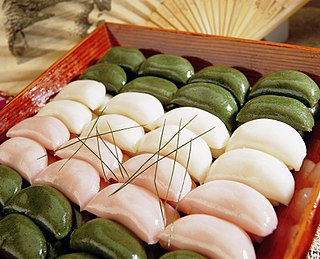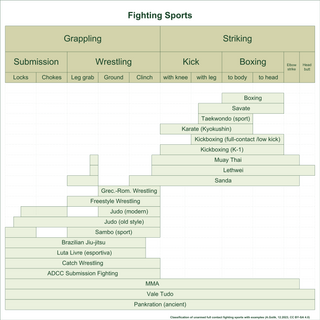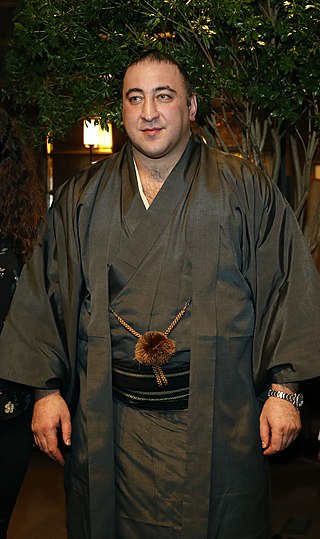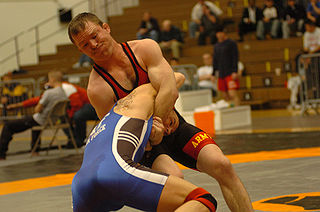Related Research Articles

Grappling is a fighting technique based on throws, trips, sweeps, clinch fighting, ground fighting and submission holds.

Sumo is a form of competitive full-contact wrestling where a rikishi (wrestler) attempts to force his opponent out of a circular ring (dohyō) or into touching the ground with any body part other than the soles of his feet.

Sports in Japan are a significant part of Japanese culture. Both traditional sports such as sumo and martial arts, and Western imports like baseball, association football, basketball and tennis are popular with both participants and spectators.

Köräş refers to a number of folk wrestling styles practiced in Central Asia. The English name comes from the term for "wrestling" in some Turkic language.

Wrestling is a martial art and combat sport that involves grappling with an opponent and striving to obtain a position of advantage through different throws or techniques, within a given ruleset. Wrestling involves different grappling-type techniques such as clinch fighting, throws and takedowns, joint locks, pins, and other grappling holds. Many different wrestling techniques have been incorporated into martial arts, combat sports, and military systems. Wrestling is genuine competition; professional wrestling is athletic theatre.

Chuseok, also known as Hangawi, is a major mid-autumn harvest festival and a three-day holiday in South Korea celebrated on the 15th day of the 8th month of the lunar calendar on the full moon. In North Korea, they only celebrate for the day of chuseok. Like many other harvest festivals around the world, it is held around the autumn equinox, i.e. at the very end of summer or in early autumn. It is the biggest traditional holiday in South Korea.

Ssireum or Korean wrestling is a folk wrestling style and traditional national sport of Korea that began in the fourth century.

Sambo is a martial art with Soviet origins, an internationally practised combat sport, and a recognized style of amateur wrestling included by UWW in the World Wrestling Championships along with Graeco-Roman wrestling and freestyle wrestling.

There are a number of martial arts styles and schools of Russian origin. Traditional Russian fist fighting has existed since the 1st millennium AD. It was outlawed in the Russian Empire in 1832. However, it has seen a resurgence after the break-up of the Soviet Union.

A combat sport, or fighting sport, is a contact sport that usually involves one-on-one combat. In many combat sports, a contestant wins by scoring more points than the opponent, submitting the opponent with a hold, disabling the opponent, or attacking the opponent in a specific or designated technique. Combat sports share a long history with the martial arts.

A folk wrestling style is any traditional style of wrestling, which may or may not be codified as a modern sport. Most cultures have developed regional forms of grappling.
Australian Aboriginal culture includes a number of practices and ceremonies centered on a belief in the Dreamtime and other mythology. Reverence and respect for the land and oral traditions are emphasised. Over 300 languages and other groupings have developed a wide range of individual cultures. Due the colonization of Australia under terra nullius concept these cultures were treated as one monoculture. Australian Aboriginal art has existed for thousands of years and ranges from ancient rock art to modern watercolour landscapes. Aboriginal music has developed a number of unique instruments. Contemporary Australian Aboriginal music spans many genres. Aboriginal peoples did not develop a system of writing before colonisation, but there was a huge variety of languages, including sign languages.

Tochinoshin Tsuyoshi is a former Georgian professional sumo wrestler from Mtskheta. He was a member of the Kasugano stable and made his professional debut in March 2006. He reached the top makuuchi division just two years later in May 2008. After a long hiatus due to injury, he began his comeback from the rank of makushita 55 in March 2014, logging four championships in a row in lower divisions on his way back to the top division in November 2014. In January 2018 he took his first and only top-division championship. In May 2018, after finishing as runner-up with a 13–2 record and a total of 37 wins in his last three tournaments, he was promoted to ōzeki. He received eleven special prizes, six for Fighting Spirit, three for Technique, and two for Outstanding Performance, as well as two kinboshi for defeating yokozuna. Tochinoshin was demoted to sekiwake after posting losing records in the first two tournaments of 2019, but returned to ōzeki after winning ten matches at the May 2019 tournament. He lost the ōzeki rank again after the September 2019 tournament, and lost his top division status after he was sidelined with a shoulder injury during the January 2023 tournament. He retired from sumo on 19 May 2023.
The World Combat Games is an international multi-sport event featuring combat sports and martial arts. The games were founded by SportAccord as a way of bringing various martial arts and combative sports to an international audience. The World Combat Games are also accompanied by a cultural program that reflects the ancient traditions and values of martial arts as well as their contribution to modern society. The games are recognised by the International Olympic Committee.
The following are the events in professional sumo during 2011.

Korea has traditional sports of its own, as well as sports from different cultures and countries.

The different styles of wrestling may be classified in various ways, such as:

The 2018 World Nomad Games is the 3rd international sports competition organized in ethnic sports. It was held in Cholpon-Ata, Kyrgyzstan from 2–8 September 2018 with 37 sports being featured in the games. Featured sports included eagle hunting, bone throwing and kok-boru. The opening ceremony was attended by President of Kyrgyzstan Sooronbay Jeenbekov, Turkish President Recep Tayyip Erdogan, Hungarian Prime Minister Viktor Orbán and Kazakh President Nursultan Nazarbayev, Azerbaijani President Ilham Aliyev and Uzbek President Shavkat Mirziyoyev. It was announced during the festival that Kyrgyzstan would not be hosting the games in 2020, saying that Turkey would be hosting the games that year.
Kene or Naga wrestling is a folk wrestling style and traditional sport of the Nagas. It is closely related to Ssireum, the traditional national sport of Korea. The objective of the sport is to bring any part of the opponent's body above the knee to the ground.
References
- ↑ "Coreeda Association of Australia". Coreedaoz.com. Retrieved 2016-07-16.
- ↑ Spirits, Jens Korff, Creative. "Aboriginal sport & traditional games". Creativespirits.info. Archived from the original on 2012-08-14. Retrieved 2016-07-16.
{{cite web}}: CS1 maint: multiple names: authors list (link) - ↑ "Blog Archive » Coreeda Assoc. of Australia | Documenting & Promoting Traditional Wrestling Styles from Around the World". Wrestling Roots. 2014-01-14. Retrieved 2016-07-16.
- ↑ "Archived copy". Archived from the original on 2011-09-27. Retrieved 2011-10-13.
{{cite web}}: CS1 maint: archived copy as title (link) - ↑ "Coreeda Association of Australia". Coreedaoz.com. Retrieved 2016-07-16.
- ↑ "Coreeda Society of Australia". Sumoaustralia.com.au. 20 February 2011. Archived from the original on 25 April 2011. Retrieved 2016-07-16.
- ↑ "Australian wrestlers to watch in Delhi". The Sydney Morning Herald . 21 September 2010.
- ↑ Coy, Tim. "From the Dreaming to the Dreamers by Gavin Dickson, Sid Harta Publishers". Sidharta.com. Archived from the original on 2013-08-22. Retrieved 2016-07-16.
- ↑ Dickson, Gavin. "From the Dreaming to the Dreamers" Sid Harta Publishers, 2010, p.79
- ↑ "Wrestling Australia". Archived from the original on 2012-04-25. Retrieved 2011-10-13.
- ↑ "Welcome to Turk Wrestling Australia". Archived from the original on 2012-04-25. Retrieved 2011-10-13.
- ↑ "Australian Celtic Wrestling | Colonial Grappling". Celticwrestling.wordpress.com. Retrieved 2016-07-16.
- ↑ "Home - African Wrestling & Sports Federation of Australia". Awsfaustralia.org. Archived from the original on 2016-08-16. Retrieved 2016-07-16.
- ↑ "Sambo Australia". Samboaustralia.com. Archived from the original on 2016-08-07. Retrieved 2016-07-16.